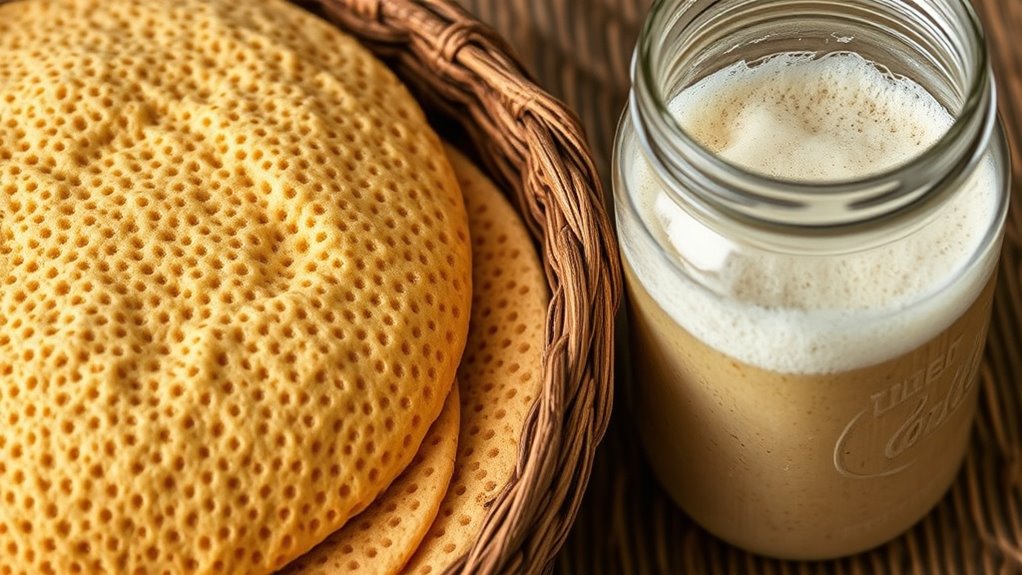Ethiopian injera is a traditional flatbread made from teff, a nutrient-rich ancient grain that has been cultivated in Ethiopia for over 3,000 years. The key to its unique taste and texture is fermentation, where wild yeasts and bacteria convert the batter over 1-3 days. This process links generations, embodies cultural identity, and promotes community bonds. If you continue exploring, you’ll discover more about teff’s history and how injera continues to shape Ethiopian heritage.
Key Takeaways
- Injera is a traditional Ethiopian flatbread made from fermented teff flour, symbolizing cultural identity and community bonding.
- Teff, an ancient Ethiopian grain, is valued for its resilience, nutritional richness, and versatility in traditional and modern dishes.
- Fermentation of teff batter, driven by wild yeasts and bacteria, lasts 1-3 days, developing distinctive flavor and airy texture.
- Proper fermentation involves soaking, stirring, and using clean containers to ensure healthful, flavorful injera.
- Modern innovations include incorporating herbs, spices, and alternative grains to adapt injera for contemporary tastes and dietary needs.
The Cultural Significance of Injera in Ethiopia

In Ethiopia, injera is more than just a staple food; it embodies the country’s cultural identity and social fabric. When you share injera, you’re participating in centuries-old traditions that unite communities and reinforce social bonds. It’s a symbol of hospitality, where offering injera signifies respect and welcoming guests. During celebrations and religious ceremonies, injera takes center stage, connecting people through shared rituals. Preparing and eating injera reflects Ethiopia’s values of community, patience, and unity. Its unique texture and taste evoke pride in local heritage. Additionally, the traditional fermentation process of teff, which is essential for injera, highlights Ethiopia’s rich agricultural practices and the importance of cultural preservation. By eating injera, you honor the cultural legacy passed down through generations, making every meal a celebration of Ethiopian identity and social cohesion.
Origins and History of Teff Grain
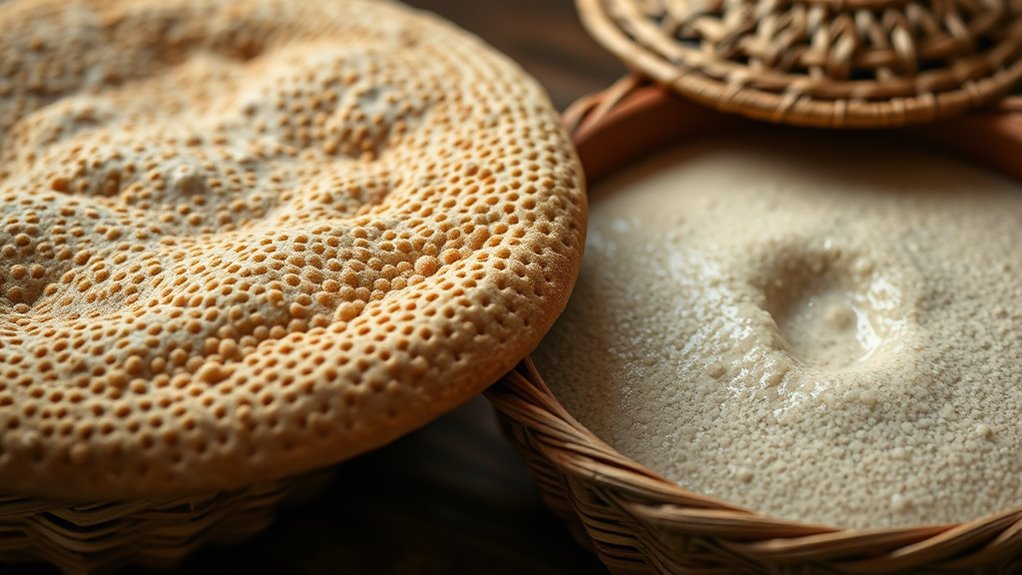
You might find it fascinating that teff has been cultivated in Ethiopia for thousands of years, making it one of the oldest grains in the region. Its cultural importance has grown over time, shaping traditions and diets across communities. Unique in both its characteristics and versatility, teff remains an essential part of Ethiopian heritage today.
Ancient Ethiopian Cultivation
Teff, a tiny but essential grain native to Ethiopia, has been cultivated for thousands of years, deeply rooted in the country’s history and culture. Its origins trace back over 3,000 years, making it one of the oldest cultivated grains in the world. You’ll find that ancient Ethiopian farmers selected teff for its resilience and adaptability to the highland climate. Throughout history, teff cultivation spread across different regions, preserving its importance in local diets. Its small size and quick growth made it ideal for small-scale farming and sustainable agriculture. Today, teff remains a cornerstone of Ethiopian agriculture, symbolizing resilience and tradition. Crop diversity has also contributed to its ability to thrive in various environments, ensuring its continued significance in Ethiopian society.
Cultural Significance Growth
Because it has been cultivated for over three millennia, teff holds a deep cultural significance in Ethiopia. It’s more than just a staple crop; it symbolizes identity, tradition, and resilience. Historically, teff was reserved for royalty, and today, it remains central to Ethiopian heritage. Its role extends beyond food, influencing social rituals and community bonds. The grain’s growth reflects Ethiopia’s history of self-sufficiency and adaptation. Here’s a quick overview:
| Aspect | Significance |
|---|---|
| Ancient Use | Royalty and rituals |
| Cultural Symbol | National pride |
| Modern Relevance | Economic staple |
| Tradition | Passed through generations |
Furthermore, understanding the cultural importance of teff can deepen appreciation for its role in shaping Ethiopian society. The grain’s nutritional value has contributed significantly to its enduring popularity, ensuring its place in both traditional and contemporary diets. Additionally, the agricultural resilience of teff has helped Ethiopia maintain food security amid changing climate conditions.
Unique Grain Characteristics
Teff’s unique qualities stem from its ancient origins and long-standing history in Ethiopia. This tiny grain has been cultivated for thousands of years, making it a staple of Ethiopian cuisine. Its resilience allows it to thrive in diverse climates and poor soils, which contributed to its survival over centuries. You’ll find that teff is known for its rich nutritional profile, including high iron and calcium content. Its small size and distinctive color variations—from white to reddish-brown—set it apart from other grains. Additionally, teff’s versatility enables it to be ground into flour for injera, used in porridge, or added to breads. Its deep roots in Ethiopian culture make it more than just a grain; it’s a symbol of tradition and resilience.
The Composition and Nutritional Benefits of Teff
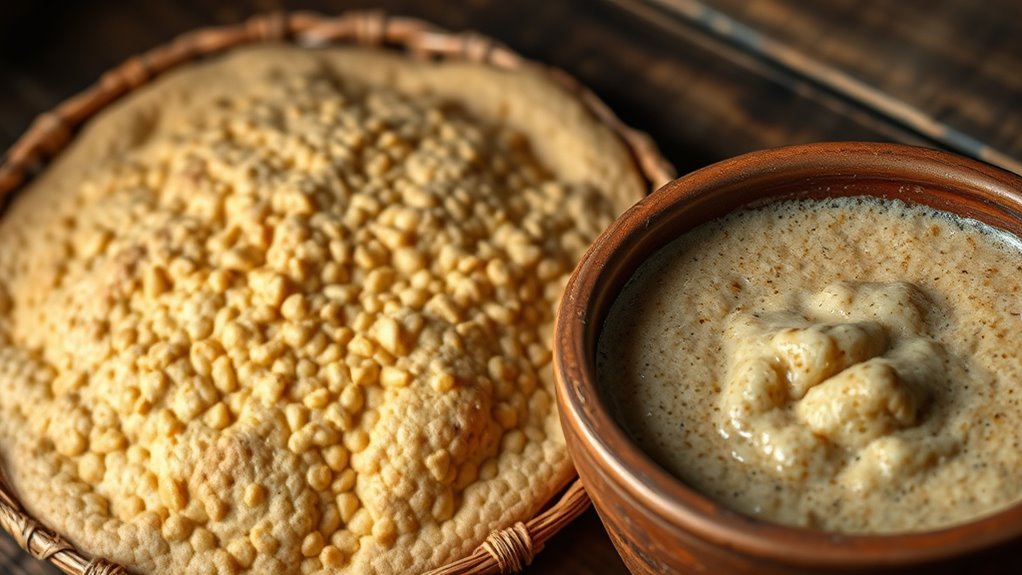
Teff is a tiny grain packed with an impressive array of nutrients that make it a valuable addition to your diet. It’s rich in protein, providing essential amino acids that support muscle growth and repair. Its high fiber content helps digestion and promotes a feeling of fullness. Teff is also an excellent source of iron, which boosts energy levels and prevents anemia, especially important for those with plant-based diets. Additionally, it contains calcium, magnesium, and zinc, supporting bone health and immune function. Low in fat and gluten-free, teff suits various dietary needs. Its complex carbohydrates offer sustained energy release, making it a nutritious choice for everyday meals. Incorporating teff into your diet can enhance overall health and provide crucial nutrients often lacking in other grains.
Traditional Methods of Preparing Injera Batter
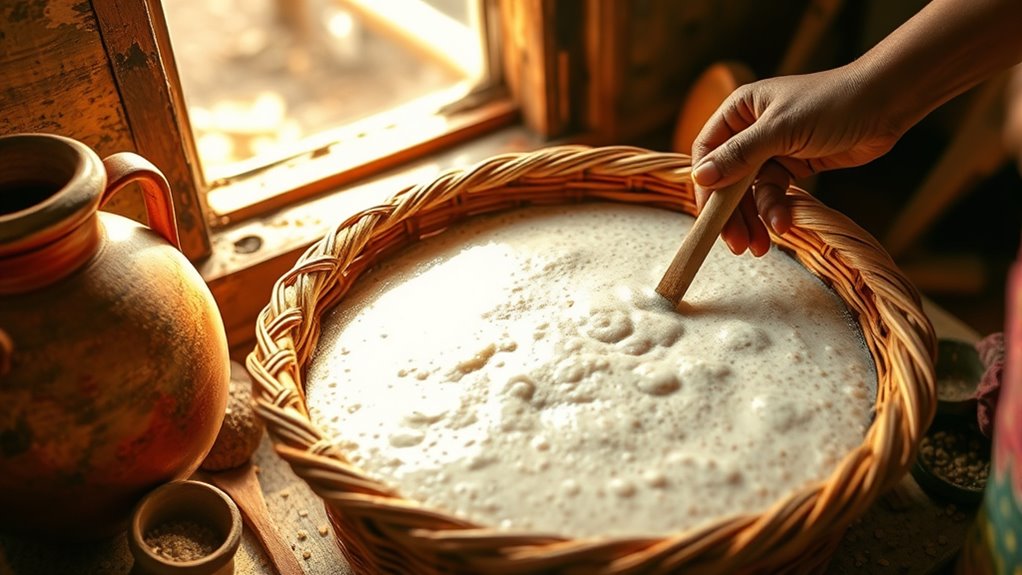
To prepare injera batter using traditional methods, you start by soaking teff grains or flour in water, allowing natural fermentation to begin. This process can take anywhere from one to three days, depending on the environment. During fermentation, wild yeasts and bacteria naturally present in the air and on the grains activate, giving the batter its distinctive sour flavor. To guarantee a successful ferment, you might:
- Use a clean clay or glass container to hold the batter.
- Cover it loosely with a cloth to let air circulate.
- Stir the mixture daily to promote even fermentation and prevent mold formation.
Once the batter has fermented to your desired sourness, you stir it well, add a little water if needed, and then pour it onto a hot griddle to cook the injera.
The Fermentation Process: From Grain to Flatbread
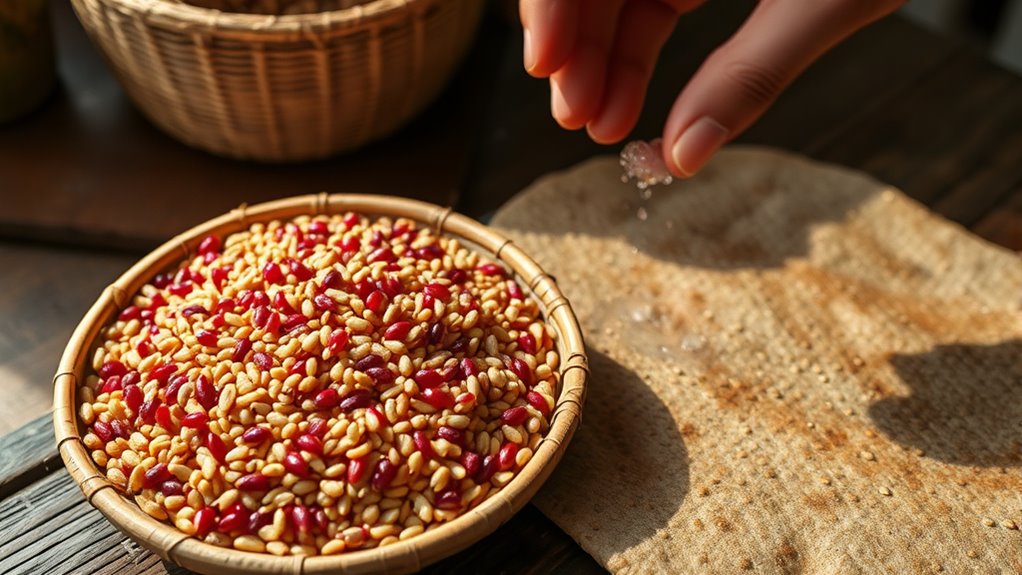
As the grains ferment, natural yeasts and bacteria transform the batter’s composition, producing lactic acid that gives injera its characteristic sour flavor. During this process, the microorganisms feed on the carbohydrates in the teff or other grains, releasing gases and acids. This fermentation typically takes one to several days, depending on temperature and desired sourness. As the acids develop, the batter becomes tangy and slightly bubbly, indicating it’s ready for cooking. You’ll notice a pleasant aroma and a thickened, slightly frothy consistency. Proper fermentation is essential for injera’s texture and flavor, as it creates the soft, spongy surface that absorbs sauces and stews. This natural process highlights the importance of patience and environmental factors in achieving the perfect injera.
Variations and Modern Adaptations of Injera
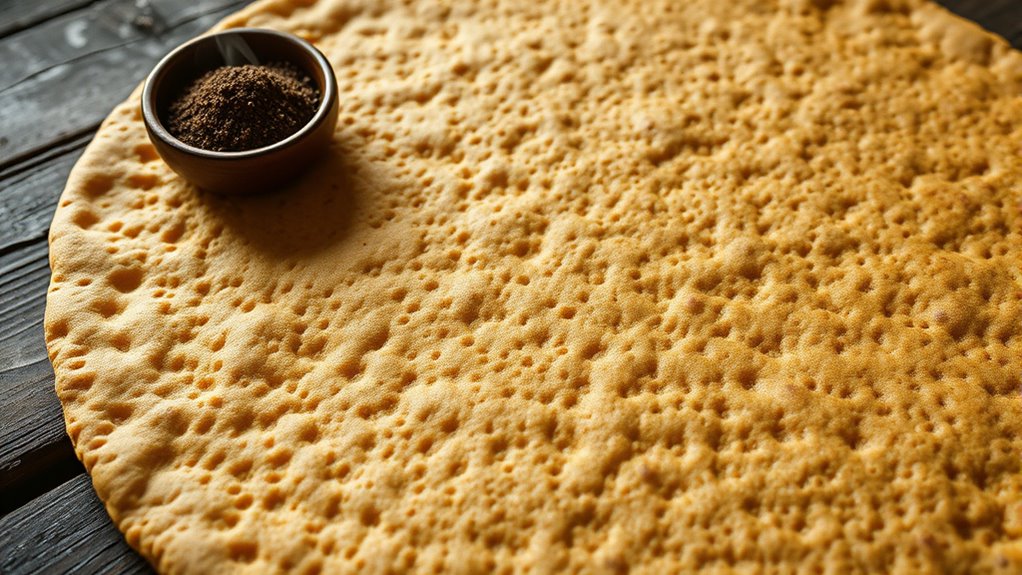
You’ll notice that cooks are now experimenting with different ingredients to create unique injera variations. Some incorporate alternative grains or add spices for new flavors, while others blend culinary traditions. These fusion innovations keep injera exciting and adaptable to modern tastes. Incorporating creative composition techniques can further enhance the presentation and flavor profiles of these innovative recipes.
Creative Ingredient Substitutions
Creative ingredient substitutions have opened new possibilities for enjoying injera outside traditional settings. You can experiment with different grains and flours to create unique flavors and textures. For example, using barley, millet, or sorghum flour can still produce a tasty, gluten-free injera. Additionally, some cooks incorporate ingredients like buckwheat or chickpea flour to add depth and nutrition. These substitutions make injera more accessible for those with dietary restrictions or limited access to teff. You might also try blending grains to achieve a balanced taste, such as combining millet and sorghum. By exploring these options, you keep the essence of injera alive while adapting it to modern tastes and ingredients. This flexibility encourages creativity and broadens the way you can enjoy this Ethiopian staple.
Fusion Culinary Innovations
Fusion culinary innovations have transformed injera from a traditional Ethiopian staple into a versatile canvas for modern flavors and techniques. You can now find injera made with gluten-free grains like millet, sorghum, or buckwheat, appealing to diverse dietary needs. Chefs experiment with adding herbs, spices, or even cheese to create unique flavor profiles. Some adapt the batter by incorporating ingredients like chickpea flour or turmeric for vibrant colors and added nutrition. These variations allow you to enjoy injera in new contexts, such as fusion dishes or contemporary brunch menus. By blending traditional fermentation methods with innovative ingredients, you can explore exciting twists on classic recipes. This evolution keeps injera relevant in global cuisine while honoring its cultural roots.
How Injera Connects Communities and Celebrates Heritage
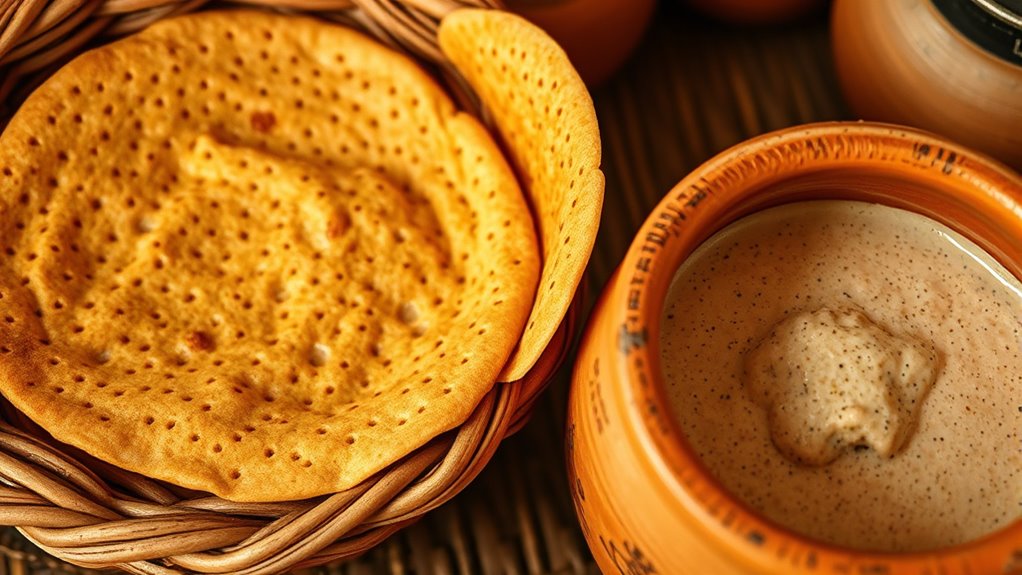
In Ethiopian culture, injera serves as more than just a staple food; it is a symbol that unites communities and preserves heritage. When you share injera during gatherings or celebrations, you participate in a tradition that brings people together. It’s common to see families and neighbors come together to prepare and enjoy injera, reinforcing social bonds. Injera also plays a role in rituals and festivals, symbolizing unity and cultural pride. The self watering plant pots concept reflects its importance in maintaining cultural identity and resilience. The diversification of traditional diets through the inclusion of injera highlights its significance in fostering community and cultural continuity. You’ll notice that:
- Shared injera fosters a sense of belonging and community spirit
- Traditional preparation methods pass down cultural knowledge
- Celebratory occasions often center around injera, emphasizing heritage and togetherness
- The process of fermentation not only enhances flavor but also serves as a vital aspect of cultural tradition, linking generations through shared practices
Frequently Asked Questions
How Does Teff Fermentation Differ From Other Grain Fermentations Worldwide?
You’re curious about how teff fermentation differs from other grains worldwide. Teff fermentations rely on unique native microorganisms, giving it a distinct sour flavor and spongy texture. Unlike wheat or rice fermentations, teff’s tiny grains contain high levels of nutrients and natural enzymes that promote rapid fermentation. This process results in a more complex, tangy taste, making teff-based products like injera stand out in flavor and fermentation dynamics globally.
What Are the Environmental Impacts of Cultivating Teff in Ethiopia?
They say, “You reap what you sow,” and that’s true for teff cultivation in Ethiopia. Growing teff impacts the environment through water use, soil erosion, and land degradation. While it’s essential for local livelihoods and food security, over-farming can harm ecosystems. Sustainable practices can help balance teff production with environmental health, ensuring future generations can also benefit from this ancient crop.
Can Teff Be Used in Gluten-Free Baking Beyond Injera?
You can definitely use teff in gluten-free baking beyond injera. Its fine flour adds a unique, nutty flavor and a dense texture to baked goods like bread, muffins, and cookies. Since teff is naturally gluten-free, it’s a great choice for gluten-sensitive or celiac diets. Just remember to combine it with other gluten-free flours or binders like xanthan gum for better structure and rise in your baked creations.
How Has Modern Technology Influenced Traditional Injera Preparation?
Modern technology has transformed how you prepare injera by making fermentation more consistent and faster. You might use temperature-controlled fermentation chambers or digital timers to monitor the process precisely. Blenders and mixers help you achieve smooth batter textures, while new storage solutions extend shelf life. These innovations enable you to produce injera more efficiently, maintain quality, and experiment with flavors, blending tradition with modern convenience in your culinary practices.
Are There Health Concerns Linked to Consuming Fermented Teff Products?
You might wonder if eating fermented teff products poses health risks. Generally, these foods are safe and beneficial, offering probiotics that support digestion. However, if you have a weakened immune system or allergies, you should be cautious. Contamination or improper fermentation could cause foodborne illnesses. To stay safe, guarantee proper fermentation practices, and consult a healthcare professional if you have specific health concerns or sensitivities.
Conclusion
Now that you’ve explored how injera and teff fermentation weave together Ethiopia’s rich heritage, you can truly appreciate their magic. This flatbread isn’t just food—it’s a symbol of unity that holds communities together like an unbreakable chain. As you savor each bite, remember you’re tasting centuries of tradition and resilience, making this humble dish an epic legend in every mouthful. Truly, injera’s story is as grand as the Ethiopian sky itself!
